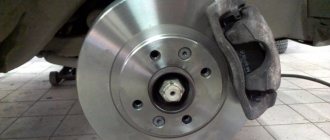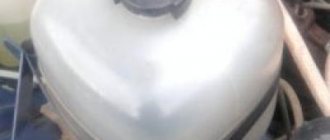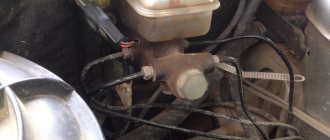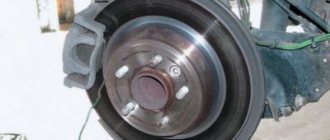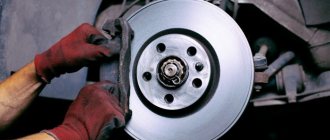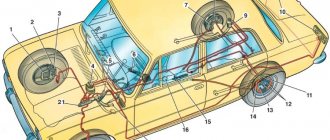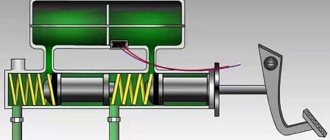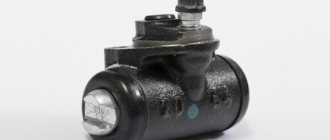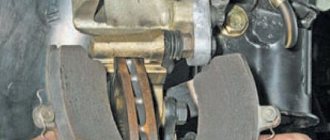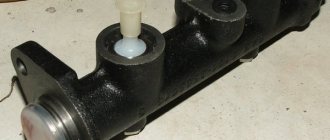18.07.2019
| (Votes: 7, Rating: 4.43) |
Issues discussed in the material:
- How do brakes work?
- What are the main causes of front brakes sticking?
- What other faults can cause the front brakes to jam?
What daily manipulations does every person who moves during the day by car do? He gets into his car, starts the engine, warms it up a little and starts driving. And here an unpleasant surprise can await him: the car does not move! If this has not happened before, then it is difficult for the driver to understand what is going on, especially if his driving experience is not yet very long. The reasons why the front brakes stick can be different. To learn how to distinguish and eliminate them, you must first understand the theoretical side of the issue.
The pistons of the brake cylinders are jammed, what should I do?
Welcome! Brake cylinders - thanks to them, braking is carried out, and without the pistons that are in them, these cylinders will not work at all, so if a piston fails, then you have to go to a car store and buy a new brake cylinder, because driving without brakes is scary and even more dangerous , but not in all cases the pistons stop working forever, sometimes they can be revived, and we will write in detail about how to do this in this article.
Note! To work, you will need to stock up on: A jack to lift any side of the car, as well as a wheel wrench and you may also have to stock up on bricks, and you may also need a basic set of wrenches and sockets!
Summary:
How to understand that the pistons of the brake cylinder are not working? Let us answer this question before we move on to the repair of pistons, namely inoperative (That is, the pistons do not move in the cylinder), the pistons are recognized if they do not move at all and stand in one place, as a result of which the car, namely the brakes, begins a number of problems occur, that is, the car cannot drive normally because it constantly slows down even though you don’t press the brake pedal at all, or it may be that the car will drive but it will brake much worse than it should, in general, let’s figure it out Why do these cylinder pistons fail?
From time to time, the sealing ring (indicated in the photo below by an arrow) that fits the piston in a circle either wears out, or micro cracks form in it through which dirt begins to get into the piston itself, where the lubricant is located, and as a result the piston becomes unusable.
And also, the piston can simply sour in the brake caliper, and this can happen because of our roads, which in winter are mostly sprinkled with sand and salt, and the brake system is located in the very bottom of the car and therefore is subject to heavy braking. and in general, when moving, all this salt flies which little by little brings the situation to the point where the piston simply rusts, otherwise it simply sours, and therefore it will then be very difficult to move it from its place and thus it stops moving and therefore stops working.
By the way, you can very easily understand if your piston is somehow soured, if your car’s fuel consumption on the highway increases, and also if the car, as already mentioned earlier, starts to drive worse, and also if you notice that In neutral gear, the car began to slow down a little, this can also be understood if the car begins to skid on a winter road from braking, all this indicates that your piston has stopped working.
How the brakes work
The serviceability and correct operation of the car's braking system determines whether you can drive it normally or not. The law prohibits driving a car with broken or jammed brakes, even if it is a minor problem. This is still unsafe for both you and other road users.
To understand possible malfunctions and understand why the front brakes jam, you need to have an idea of the principle of their operation. The braking system in modern cars consists of brake discs or drum pads, which mechanically, if necessary, slow down the speed of the car. The system works like this: the brake pedal is pressed, the piston in the main brake cylinder moves, “adjusting” the brake fluid, which, in turn, passing through the lines, affects the brake cylinders of the wheels. They press pads equipped with a friction mixture against the discs or drums. This leads to braking.
In addition, the brake system is equipped with an expansion tank for brake fluid and a vacuum booster, thanks to which you only need to press lightly on the pedal. There are quite a few car models equipped with a special electronic system (ABS) that prevents the wheels from locking during braking.
We recommend
“How to brake correctly with manual transmission at any time of the year” Read more
How to turn an inoperative brake cylinder piston into a functional one?
1) At the very beginning of the operation, you will need to remove the wheel from the car.
Note! By the way, when you remove the wheel from the car, try to spin it while it is in the air; if it slows down, then some piston has actually become unusable!
2) After your wheel is removed, immediately remove the caliper from the car after it in order to get out the brake piston that is not working. (For information on how to remove the brake caliper on front-wheel drive cars, see the article: “Replacing the brake caliper on a VAZ 2109”, and for information on how to remove this caliper on a classic, see “this article”)
3) Now, when the caliper is removed from the car, you will need to find a vice, or a very strong compressor, in order to remove the piston from the brake cylinder, so if you have a vice, then go to it and clamp the piston itself and behind the caliper after Once you clamp the piston, pull it, and thereby the piston will be removed from its installation location.
Jamming of brakes on a VAZ 2106-2103 car
If while driving your car you feel that the engine speed sometimes decreases and at the same time you are sure that there are no problems with the engine, then it is quite possible that the brakes are starting to jam a little, you can also check this after stopping, wheel rims If the brakes jam, they get very hot.
What can cause the brakes to jam on the VAZ 2106 and other models from the “classic” series?
- The master cylinder pistons may be seized. This can also include a malfunction such as a clogged compensation hole in the master cylinder.
- The vacuum booster valve body may also become stuck. As a rule, valve jamming occurs due to swelling of the diaphragm or pinching of the amplifier cover seal. The protective cap could also be jammed.
- The vacuum booster adjusting bolt should protrude a certain distance relative to the plane of the master cylinder; check whether this distance is not violated.
- Incorrect adjustment or complete lack of free play of the brake pedal. Adjust the position of the brake light switch.
- If oil, gasoline or other liquids get into the brake system, the rubber cuffs of the master cylinder, as well as the cuffs of the wheel cylinders, may swell, as a result of which the cylinders do not release the brakes.
- The gaps between the rear brake pads and the brake drum are broken or incorrectly adjusted.
- The circulation of brake fluid through the brake pipes is disrupted; this can also be caused by clogged pipes and mechanical damage.
- Check the operation of the parking brake; it may not release the rear pads after use. This could happen either due to the fault of the driver himself, who simply did not lower the handbrake all the way, or due to a failure of the parking brake cable.
- Due to dirt getting on the working surfaces of the brake cylinders, the pistons could jam.
- The release rod on the brake pedal is incorrectly adjusted.
Perhaps that's all. These are the most basic malfunctions that can occur and lead to jamming of the VAZ 2106 brakes.
Source
Why does the brake caliper squeak and jam?
Secondary causes of jamming:
- the pads are not installed correctly initially, so they begin to creak;
- discs are worn out by 70–80 percent - due to aggressive driving style or natural reasons;
- the lubricant is incorrectly selected or is missing;
- Dirt and moisture got inside the mechanism.
One of the main reasons why a mechanism creaks or jams is overheating. Friction during active braking causes heat production. This causes high loads not only on the pads, but also on the presser itself. Therefore, at least conscientious manufacturers try to make it from the most durable material.
Symptoms of a problem
- oily spots on the visible or inner side of the wheel, which indicates a leak of DOT fluid, a decrease in its level in the expansion tank;
- unexpected, spontaneous pulling of the car to the side after braking - while the wheels are normally inflated and the suspension is fully operational;
- a grinding sound after releasing the brake pedal is the main sign of a situation where the piston is pressed in and does not return to its original position;
- The discs overheat greatly and give off an unpleasant burnt smell - even after driving with relatively infrequent braking.
VAZ 2112 front brakes sticking reason
- To the beginning of the forum
- Forum Rules
- Old design
- FAQ
- Search
- Users
and what exactly can be in a university?
We perform assembly in reverse order.
When the engine is not running, the free play of the brake pedal should be 3-5 mm.
We adjust the free play by moving the brake light switch while the nut securing it is loosened. The brake light switch is installed so that its buffer rests against the pedal stop with a free travel of the brake pedal of 3-5 mm. In this position, tighten the brake light switch mounting nut.
Guys, wow. help is needed! The brakes recently hissed - I changed the vacuum seal, everything became ok. After replacing the VU, I drove about 100 km, and began to feel that the car was not pulling... After 5 km, it completely stopped, so that you couldn’t move it. Both front wheels are blocked. The pedal is dead, you can't press it. It stood for half an hour - it cooled down, it drove off, but not perfectly, but also with effort. after 5 km it stopped again.. the brake discs were red, hot.. I unscrewed the hose to the front wheels from the GTZ, bleed the brakes - it helped.. but at 10 km.. I looked at the pads, brake cylinders - everything is fine.. What kind of nonsense could this be? ? Could it be because of the vacuum seal? and in general the situation is strange... the car has diagonal brake circuits, but both front ones are blocked. Help whoever can.
What to do if the caliper is stuck on the road
The first thing that is recommended is to give the elements half an hour to cool down. Then identify the problem wheel by conducting an effective test. You need to drive 20–30 meters, stop and touch all four disks with your finger through the provided holes. If the part is hot, it is this particular wheel that jams. It is removed, the car is first placed on a jack.
Cold water will help to quickly cool the elements, but you can water it on a surface that has already partially cooled. Otherwise, the disk will simply blow apart due to strong temperature changes.
If the handbrake cable jams, the inner or outer braid is most likely damaged. It is possible that the return spring has weakened and needs to be replaced with a new one. Also, both return brackets often become dirty. In this case, they must be cleaned of rust and treated with VD-40.
But what to do if sometimes you don’t have time for all this. Then the only way remains is to hit the return bracket with a hammer so that the cable returns to its original position. You can drive further, but just don’t use the handbrake again until it is repaired.
If the piston itself is jammed, a hammer can also quickly solve the problem. You need to tap it carefully, through a wooden spacer, throughout the entire mechanism. If the pads do not wedge, try inserting a screwdriver between the pad and the disc. Finally, the surest, but most dangerous way is to squeeze the hose with a clamp. But you must drive extremely carefully, without brakes.
VAZ 2112 front brakes sticking reason
read about the modification of the sorcerer
This has long been known and has no significance here.
I didn’t go into the wilds too much, read about the modification of the sorcerer, here it was about the puck
It is clear that it’s not that he “didn’t climb much,” but in general, he didn’t even come close to the wilds.
That modification (about the washer) is so that the REAR wheels brake EQUALLY evenly, i.e. so that it doesn’t happen that one rear wheel goes into a skid, and the other barely slows down. It has nothing to do with the front ones. The sorcerer has nothing to do with the front end at all.
Added after 5 minutes 44 seconds:
So it’s in vain that you were given advice here.
The sorcerer has nothing to do with the front end at all
The car sat for a day and no one touched it (I wanted to look at the engine speed), so after sitting idle the pads themselves completely loosened.[/s]
what could be the problem
After sitting idle, the pads completely loosened up on their own.
This is how it should have happened. And they would loosen even faster if you unscrewed and tightened any of the fittings on the problem wheels.
You won’t be able to drive like that anyway. Adjust the VUT rod!
t808
Replacement of the GTZ, for example, VUT, or something else.
But Fank790
didn’t say anything about it. Is it getting dark?
The GTS was changed 4 years ago, the vacuum tank is original and no one has climbed into it. What I discovered yesterday was that I couldn’t bleed the right rear wheel, the brake almost doesn’t come out and the pedal doesn’t fall (I read somewhere, it’s like the sorcerer has caught himself)
I couldn’t bleed the right rear wheel, the brake hardly comes out and the pedal doesn’t fall
I read somewhere, like the sorcerer was covered
Here we'll talk about the screwdriver and the sequence of pumping the circuits.
Added after 22 minutes 27 seconds:
In pursuit. Here, in the second photo, the hand puts the dipstick into the gap.
Instead of a feeler gauge, you need to firmly push the tip of a flat-head screwdriver into this gap. Now download it!
I, of course, am in favor of checking and adjusting the VUT rod, but... What could have happened to him?
It’s easier for me to repair than to waste time guessing, especially since 15 minutes is more than enough for a pair of nuts. And the reasons for this can be different, including a frog that has become unscrewed and then incorrectly secured.
Express check of the extension of the VUT rod: 1. Loosen the nuts securing the GTZ to the VUT 2. Between them, under the GTZ flange on both sides, we slip two pieces of a hacksaw blade for metal 3. Tighten the nuts. 4. We do a test drive with braking systems of different effectiveness. 5.After the trip, check the uniform heating of the mounting bolts on all four wheels.
Source
Consequences
When the bracket wedges, the block remains pressed. This causes the discs to become very hot and the shoes to burn. If the speed of movement is high, and the degree of constriction is maximum, then it’s red-hot. It is obvious that braking efficiency drops sharply, the linings and disc become washed out and lose their properties.
After several heating and cooling procedures, the disks are sure to become deformed. After pressing the pedal, you will feel a beating, and you will not be able to brake at all. You will have to replace the repair kit, but the troubles will not end there, because the cause of the malfunction is in the caliper. If the hub begins to heat up, then the bearing will crumble and the CV joint will be destroyed.
Posts 1 to 20 of 28
1 Topic by OlegD 2015-03-16 20:43:46
- OlegD
- Connoisseur
- Inactive
- From: Moscow
- Registration: 2014-01-15
- Messages: 511 Thanks : 115
- Car: 21114, door 21124 1.6 l., 2007 onwards
Topic: Resolved: Front brakes are pinching the disc
Looks like my summer theme continues. There I had a problem with the rear brakes, and now I have the same problem with the front. The pads do not release the discs completely, which causes the wheel to spin poorly. It seems that this problem began at the same time as with the rear brakes (it was noticeable by the characteristic sound of the pads rubbing, but then I ignored it), only now it has worsened. The car has even become difficult to accelerate, and the hanging wheel can only be turned with difficulty (the right one is more difficult, the left one is easier).
It is clear that in the brake system, malfunctions of various components can have such an effect. But for now it seems to me that it is the brake master cylinder that is sticking. This is supported by the fact that the problem was with the rear, and now with the front brakes. By the way, the rear ones are now in perfect order.
It also happens from time to time that there is a strong beating in the steering wheel and vibration in the car at a speed of about 90 km/h. Then it passes. Looks like these are related problems.
Do you think there could be a problem with VUT? Is it worth buying and installing a brake master cylinder repair kit or is it a waste of time?
Source
Prevention measures
Maintenance of the caliper must be carried out every time the pads are replaced, every two years. It is during this period that the lubricant loses its original properties. In Russian conditions, the timing of the inspection activity must be significantly reduced, and an inspection must be carried out in case of any extraneous sounds, the vehicle slipping and other signs of damage to the mechanism listed above.
The large loads to which the clamp is subjected require the use of special lubricants. Poor-quality compounds quickly harden and are destroyed by water or aggressive brake fluid. You need to use only high-temperature lubricant, with minimal dripping characteristics, moisture-resistant and not susceptible to chemicals. In addition, the correct lubricant must be compatible with plastic and rubber parts. A special type of lubricant is used for the fingers—the elements that guide the mechanism’s brackets.

